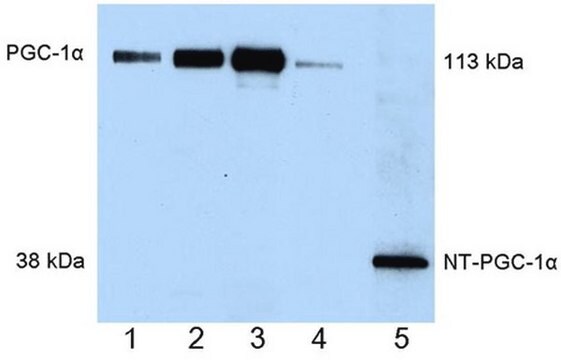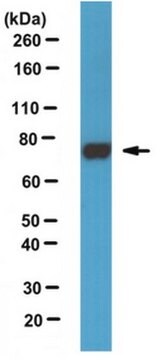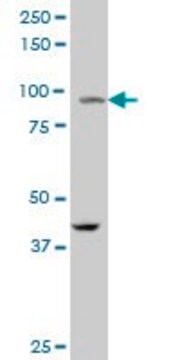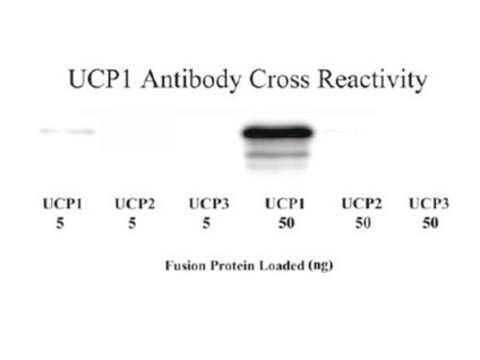AB3242
Anti-PGC-1 Antibody
Chemicon®, from rabbit
Synonym(s):
Peroxisome proliferator-activated receptor gamma coactivator 1-alpha, Ligand effect modulator 6, PGC-1-alpha, PPAR-gamma coactivator 1-alpha, PPARGC-1-alpha
About This Item
Recommended Products
biological source
rabbit
Quality Level
antibody form
affinity isolated antibody
antibody product type
primary antibodies
clone
polyclonal
purified by
affinity chromatography
species reactivity
mouse, rat, human
manufacturer/tradename
Chemicon®
technique(s)
ELISA: suitable
immunocytochemistry: suitable
immunofluorescence: suitable
immunohistochemistry: suitable
immunoprecipitation (IP): suitable
western blot: suitable
NCBI accession no.
UniProt accession no.
shipped in
dry ice
target post-translational modification
unmodified
Gene Information
human ... PPARGC1A(10891)
General description
Specificity
Immunogen
Application
Immunocytochemistry Analysis: A 1:300 dilution of a previous lot was used in Immunocytochemistry.
Immunofluorescence Analysis: Representative lots detected PGC-1α in frozen mouse and rat muscle tissue sections (Gouspillou, G., et al. (2013). Longev. Healthspan. 2(1):13; Matsuura, T., et al. (2007). J. Orthop. Res. 25(11):1534-1540).
Immunohistochemistry Analysis: A representative lot detected PGC-1α in free-floating mouse forebrain sections (Tallaksen-Greene, S.J., et al. (2014). J Neurosci. 34(47):15658-15668).
Immunoprecipitation Analysis: Representative lots immunoprecipitated PGC-1α from mouse liver, skeletal muscle, and brown adipose tissue lysates (Boutant, M., et al. (2016). Cell Rep. 14(9):2068-2075; Park, R.D., et al. (2014). J. Exerc. Nutrition Biochem. 18(1):1-7; Kim, J.S., et al. (2014). J. Exerc. Nutrition Biochem. 18(3):259-266; Philip, A., et al. (2011). J. Biol. Chem. 286(35):30561-30570).
Western Blotting Analysis: Representative lots detected similar PGC-1α in human, mouse, and rat skeletal muscle tissue, as well as in nuclear and mitochondrial preparations from rat brown adipose tissue (Suwa, M., et al. (2015). J. Sports Sci. Med. 14(3):548-555; Lee, I., et al. (2015). Front. Pharmacol. 6:43; Vincent, G., et al. (2015). Front Physiol. 6:51; Lombardi, A., et al. (2015). PLoS One. 10(2):e0116498; Gouspillou, G., et al. (2014). FASEB J. 28(4):1621-1633; Saleem, A., et al. (2014). Am. J. Physiol. Cell Physiol. 306(3):C241-249).
Epigenetics & Nuclear Function
Transcription Factors
Quality
Western Blotting Analysis: A 1:1,000 dilution of this antibody detected recombinant mouse PGC-1, as well as endogenous PGC-1 in 15 µg of nuclear extract and whole cell lysate from mouse brown adipose tissue (BAT). Immunogen peptide blocking completely blocked target band detection.
Target description
Physical form
Storage and Stability
Analysis Note
BAT nuclear prep
Legal Information
Disclaimer
Not finding the right product?
Try our Product Selector Tool.
Storage Class
12 - Non Combustible Liquids
wgk_germany
WGK 2
flash_point_f
Not applicable
flash_point_c
Not applicable
Certificates of Analysis (COA)
Search for Certificates of Analysis (COA) by entering the products Lot/Batch Number. Lot and Batch Numbers can be found on a product’s label following the words ‘Lot’ or ‘Batch’.
Already Own This Product?
Find documentation for the products that you have recently purchased in the Document Library.
Customers Also Viewed
Our team of scientists has experience in all areas of research including Life Science, Material Science, Chemical Synthesis, Chromatography, Analytical and many others.
Contact Technical Service












